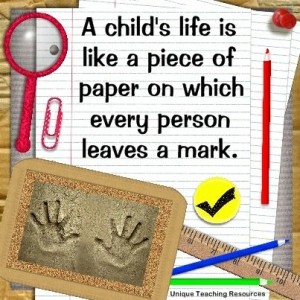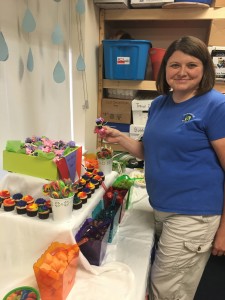From the Principal’s Desk:
Good Night, Sleep Tight:Preschoolers and Sleep

Parents of young kids know how precious sleep can be. It’s important to remember that a lack of sleep can impact your preschooler’s behavior and ability to have a good day at preschool. Grumpiness, low energy, and extremes in behavior could all by signs that your child needs more sleep.
While experts agree about the value of sleep, they also recognize that not all kids need the exact same amount. In general though, one to three year olds need between 12-14 hours of sleep per day. Most kids this age take one long nap and go to bed between 7 and 9 p.m. Kids ages three to six years old typically need between 10-12 hours of sleep per day.
To help your child understand the difference between a body at rest and a body at play, try this simple experiment:
- When your child is calm and resting, help him count his pulse during a one-minute interval.
- Write down the number of beats counted.
- Then have your child get up and do an active movement for several minutes. Try jumping jacks, running, or hopping up and down.
- Once again, help your child count his pulse during a one-minute interval.
- Compare the rate of your child’s pulse when resting to when active.
At the end of the day, help your child make observations about what happens when she gets tired. When it draws close to bedtime, ask your child how she feels. What are the signs her body gives that tell her that it is time to rest? (yawning, drooping eyelids, or a “heavy” head).
Take that sleepy-time opportunity to cuddle up with some good books for story time. Reading stories before bedtime makes a good transition between active play and rest time and should be a part of the bedtime routine. Those special, quiet moments with books will become special memories for you and your child.
Reprinted with permission from the National Network for Child Care – NNCC. Self, F. (1996). Making the most of outdoor play. In Todd, C.M. (Ed.), *Child care center connections*, 5(3), Urbana-Champaign, IL: University of Illinois Cooperative Extension Service.
Inspirational Quotes for parents

Volunteer Spotlight:




We would like to thank Lauren Scott and Ashley Schlicker for there amazing April Showers theme teacher appreciation event. The teacher’s loved the fruits and veggies and especially the fun nail polish!
A big thank you goes to Bruce Schlicker for distributing 60 bags of sand to all the playgrounds! We couldn’t have done it with out you!

I want to thank each of you for the participation in our recent fundraisers! Participation in our fundraising events is optional for all families. We feel that by offering a wide range of fundraisers, families can pick the ones that work for their family!
With the sales from our fundraisers we are able to purchase extra supplies for the classroom.
If you have ideas for any local fundraisers, please let me know and I will research the idea to see if we can offer it.
Thank you for supporting our school!

Parent Reminders
-
Please be sure to wash your child’s hands upon entering the classroom.
-
If your child has received any new immunizations, please make sure we have an updated record in your child’s file.
-
All outside food must be store bought.
-
Inform the front office if your emergency contact information changes.
-
Please sign your child in and out each day.
-
Label all your child’s belongings.
-
Please put appropriate foot wear on your child for active play.
ANCILLARY PROGRAMS





Monday Morning: Daisy Dance is a ballet, tap and a creative movement dance program designed to teach children a life long love of movement and provide a foundation for all dance genres. Please click here for the registration form. You can add dance at the beginning of each month.
Tuesday Morning: Preschool Music Adventure is an original approach that successfully engages active preschoolers in musical activities, in order to enhance their overall development. We are very excited about this new music program. We will have a new music session starting May 10- June 14(6 weeks). Registration form are available at the front desk.
Wednesday Afternoon: T.O.T (Teams of Tomorrow) is an awesome training program that focuses on basketball handling and dribbling skills. The onsite classes are fun, educational and active. Please click here to access the registration form.
Thursday Morning: Soccer Shots is a popular non-competitive youth soccer program. This program teaches confidence, fun, character, teamwork, coordination and imagination. The summer soccer shots will start June 16th-Aug.11th. Click here for the registration forms.
Friday Morning: King Tiger Tae Kwon Do is taught according to individual needs and levels of skills. Students begin to establish, and actually achieve, personal goals. Students learn that, by setting realistic goals and applying dedication and hard work, anything is possible. They develop confidence! The virtues of Respect, Concentration, Discipline, and Motivation are the characteristics of a truly confident individual.
Building Your Child’s Sense of Family Belonging
Relationships with family members play an important role as children begin to develop a sense of self. When they feel a sense of identity and belonging within their own families, children are better able to grow emotionally, make friends, and appreciate and accept the diversity of others.
With Mother’s Day right around the corner, it’s a great time to share activities that celebrate the importance of family.
Below are age appropriate activities that we implement in the classroom, as well as activities you can do with your child at home.
INFANTS/TODDLERS:
In the classroom: Teachers use baby sign language to help children identify and eventually verbalize names for their family members. When parents enter the classroom, teachers say, “Look! Here’s Sophia’s mommy,” while also signing “mommy.” They work with parents to learn specific names used at home, and then use those names in the classroom.
At home: Use baby sign language as you come across names of family members in books and songs. To sign “mommy,” tap your thumb on your chin repeatedly. To sign “daddy,” tap your thumb on your forehead repeatedly. Remember to say the word aloud as you sign.
Recommended reading: Spot Loves His Mommy by Eric Hill, Are You my Mother? by PD Eastman
BEGINNERS (ages 2-3):
In the classroom: By age two, children begin to learn the names of extended family members, such as grandmother, uncle and cousin. They practice using these words as they talk about their families. After sorting stuffed animals by type, teachers might say, “This is the horse’s family. He has a big family. Who’s in your family?”
At home: Give your child play dough and encourage him to create the members of his family. Afterward, ask him to count and name them. This activity helps him conceptualize that multiple people make up his entire family and gives you insight into what family means to your child at his particular point in development.
Recommended reading: On Mother’s Lap by Ann Herbert Scott, Oonga Boonga by Frieda Wishinsky
INTERMEDIATES (ages 3-4):
In the classroom: As children read stories about diverse families, teachers encourage them to share unique details about their own families. For example, teachers might ask, “Who has a sister?” or “Who has a pet?” Afterward, students create charts with the information.
At home: Have each member of your family make a thumbprint using finger paint on a piece of paper side by side. Then, ask your child to compare the various sizes, and guess which thumbprint belongs to each person. As they talk about their family members, they begin to appreciate what makes their family unique.
Recommended reading: Clifford’s Family by Norman Bridwell, What Mommies Do Best and What Daddies Do Best by Laura Numeroff
PRE-K/PRE-K 2 (ages 4-5):
In the classroom: Our older preschoolers begin to understand that their parents have more than one role. Family members are invited to visit and talk to the class about their roles inside and outside of the home. Students are encouraged to write and draw their family members in the different roles they serve. For example, “Mommy is a doctor.”
At home: Go on an uninterrupted family outing with your child. Try to avoid checking work emails or answering unimportant phone calls. Afterward, ask your child to write about his favorite parts of the day in his journal.
Recommended reading: Does a Kangaroo Have a Mother Too? by Eric Carle, The Napping House by Audrey Wood
All of our schools will be celebrating families in really fun ways this Mother’s Day season, and we hope that you do too!
– Lauren Starnes, PhD – Director of Early Childhood Edu

May Newsletter
From the Principal’s Desk:
Good Night, Sleep Tight:Preschoolers and Sleep
Parents of young kids know how precious sleep can be. It’s important to remember that a lack of sleep can impact your preschooler’s behavior and ability to have a good day at preschool. Grumpiness, low energy, and extremes in behavior could all by signs that your child needs more sleep.
While experts agree about the value of sleep, they also recognize that not all kids need the exact same amount. In general though, one to three year olds need between 12-14 hours of sleep per day. Most kids this age take one long nap and go to bed between 7 and 9 p.m. Kids ages three to six years old typically need between 10-12 hours of sleep per day.
To help your child understand the difference between a body at rest and a body at play, try this simple experiment:
At the end of the day, help your child make observations about what happens when she gets tired. When it draws close to bedtime, ask your child how she feels. What are the signs her body gives that tell her that it is time to rest? (yawning, drooping eyelids, or a “heavy” head).
Take that sleepy-time opportunity to cuddle up with some good books for story time. Reading stories before bedtime makes a good transition between active play and rest time and should be a part of the bedtime routine. Those special, quiet moments with books will become special memories for you and your child.
Reprinted with permission from the National Network for Child Care – NNCC. Self, F. (1996). Making the most of outdoor play. In Todd, C.M. (Ed.), *Child care center connections*, 5(3), Urbana-Champaign, IL: University of Illinois Cooperative Extension Service.
Inspirational Quotes for parents
Volunteer Spotlight:
We would like to thank Lauren Scott and Ashley Schlicker for there amazing April Showers theme teacher appreciation event. The teacher’s loved the fruits and veggies and especially the fun nail polish!
A big thank you goes to Bruce Schlicker for distributing 60 bags of sand to all the playgrounds! We couldn’t have done it with out you!
I want to thank each of you for the participation in our recent fundraisers! Participation in our fundraising events is optional for all families. We feel that by offering a wide range of fundraisers, families can pick the ones that work for their family!
With the sales from our fundraisers we are able to purchase extra supplies for the classroom.
If you have ideas for any local fundraisers, please let me know and I will research the idea to see if we can offer it.
Thank you for supporting our school!
Parent Reminders
ANCILLARY PROGRAMS
Monday Morning: Daisy Dance is a ballet, tap and a creative movement dance program designed to teach children a life long love of movement and provide a foundation for all dance genres. Please click here for the registration form. You can add dance at the beginning of each month.
Tuesday Morning: Preschool Music Adventure is an original approach that successfully engages active preschoolers in musical activities, in order to enhance their overall development. We are very excited about this new music program. We will have a new music session starting May 10- June 14(6 weeks). Registration form are available at the front desk.
Wednesday Afternoon: T.O.T (Teams of Tomorrow) is an awesome training program that focuses on basketball handling and dribbling skills. The onsite classes are fun, educational and active. Please click here to access the registration form.
Thursday Morning: Soccer Shots is a popular non-competitive youth soccer program. This program teaches confidence, fun, character, teamwork, coordination and imagination. The summer soccer shots will start June 16th-Aug.11th. Click here for the registration forms.
Friday Morning: King Tiger Tae Kwon Do is taught according to individual needs and levels of skills. Students begin to establish, and actually achieve, personal goals. Students learn that, by setting realistic goals and applying dedication and hard work, anything is possible. They develop confidence! The virtues of Respect, Concentration, Discipline, and Motivation are the characteristics of a truly confident individual.
Building Your Child’s Sense of Family Belonging
Relationships with family members play an important role as children begin to develop a sense of self. When they feel a sense of identity and belonging within their own families, children are better able to grow emotionally, make friends, and appreciate and accept the diversity of others.
With Mother’s Day right around the corner, it’s a great time to share activities that celebrate the importance of family.
Below are age appropriate activities that we implement in the classroom, as well as activities you can do with your child at home.
INFANTS/TODDLERS:
In the classroom: Teachers use baby sign language to help children identify and eventually verbalize names for their family members. When parents enter the classroom, teachers say, “Look! Here’s Sophia’s mommy,” while also signing “mommy.” They work with parents to learn specific names used at home, and then use those names in the classroom.
At home: Use baby sign language as you come across names of family members in books and songs. To sign “mommy,” tap your thumb on your chin repeatedly. To sign “daddy,” tap your thumb on your forehead repeatedly. Remember to say the word aloud as you sign.
Recommended reading: Spot Loves His Mommy by Eric Hill, Are You my Mother? by PD Eastman
BEGINNERS (ages 2-3):
In the classroom: By age two, children begin to learn the names of extended family members, such as grandmother, uncle and cousin. They practice using these words as they talk about their families. After sorting stuffed animals by type, teachers might say, “This is the horse’s family. He has a big family. Who’s in your family?”
At home: Give your child play dough and encourage him to create the members of his family. Afterward, ask him to count and name them. This activity helps him conceptualize that multiple people make up his entire family and gives you insight into what family means to your child at his particular point in development.
Recommended reading: On Mother’s Lap by Ann Herbert Scott, Oonga Boonga by Frieda Wishinsky
INTERMEDIATES (ages 3-4):
In the classroom: As children read stories about diverse families, teachers encourage them to share unique details about their own families. For example, teachers might ask, “Who has a sister?” or “Who has a pet?” Afterward, students create charts with the information.
At home: Have each member of your family make a thumbprint using finger paint on a piece of paper side by side. Then, ask your child to compare the various sizes, and guess which thumbprint belongs to each person. As they talk about their family members, they begin to appreciate what makes their family unique.
Recommended reading: Clifford’s Family by Norman Bridwell, What Mommies Do Best and What Daddies Do Best by Laura Numeroff
PRE-K/PRE-K 2 (ages 4-5):
In the classroom: Our older preschoolers begin to understand that their parents have more than one role. Family members are invited to visit and talk to the class about their roles inside and outside of the home. Students are encouraged to write and draw their family members in the different roles they serve. For example, “Mommy is a doctor.”
At home: Go on an uninterrupted family outing with your child. Try to avoid checking work emails or answering unimportant phone calls. Afterward, ask your child to write about his favorite parts of the day in his journal.
Recommended reading: Does a Kangaroo Have a Mother Too? by Eric Carle, The Napping House by Audrey Wood
All of our schools will be celebrating families in really fun ways this Mother’s Day season, and we hope that you do too!
– Lauren Starnes, PhD – Director of Early Childhood Edu